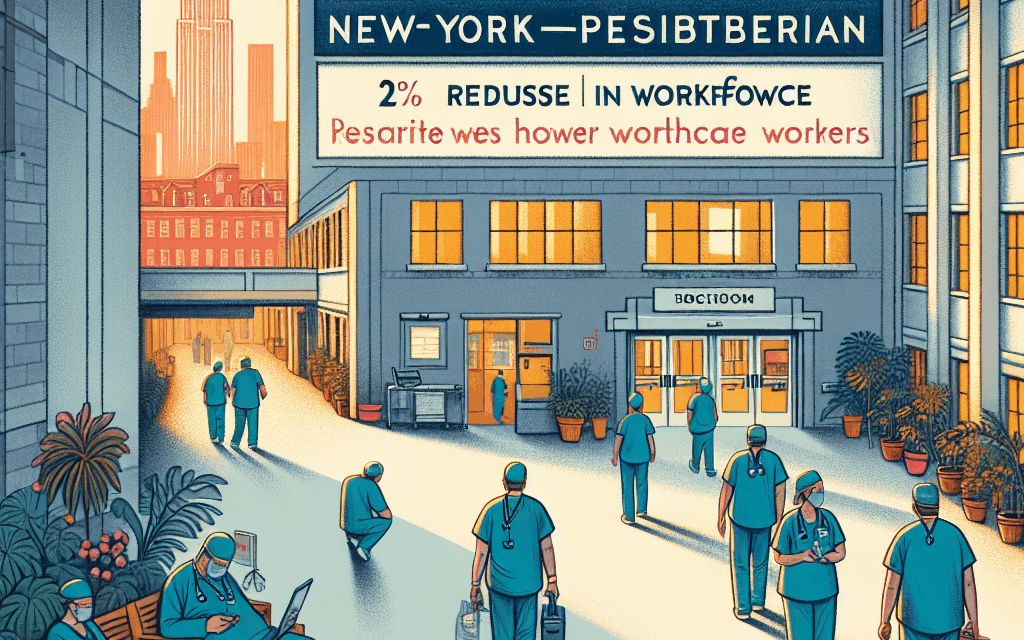NewYork-Presbyterian Reduces Workforce by 2%
In a significant move that has sent ripples through the healthcare community, NewYork-Presbyterian (NYP) announced a workforce reduction of 2%. This decision, while not uncommon in the current economic climate, raises questions about the future of healthcare employment, patient care, and the operational strategies of one of the largest healthcare systems in the United States. This article delves into the reasons behind this decision, its implications for the healthcare sector, and the broader context of workforce reductions in the industry.
Understanding the Context of Workforce Reductions in Healthcare
The healthcare industry has been undergoing transformative changes over the past few years, driven by various factors including technological advancements, economic pressures, and shifts in patient care models. Workforce reductions, while often seen as a last resort, have become a strategy for many healthcare organizations aiming to streamline operations and reduce costs.
According to a report by the American Hospital Association, nearly 30% of hospitals in the U.S. have reported workforce reductions in the past year. This trend is not limited to NewYork-Presbyterian; it reflects a broader pattern across the healthcare landscape. Factors contributing to these reductions include:
- Financial Pressures: Many healthcare systems are facing significant financial challenges, exacerbated by the COVID-19 pandemic. Increased operational costs and reduced patient volumes have led to budget constraints.
- Technological Advancements: The rise of telemedicine and automation has changed the way healthcare is delivered, often requiring fewer staff for certain functions.
- Changing Patient Demographics: As the population ages and healthcare needs evolve, organizations must adapt their workforce to meet new demands.
- Regulatory Changes: New policies and regulations can impact staffing needs, leading to adjustments in workforce size.
- Operational Efficiency: Many organizations are seeking to improve efficiency through lean management practices, which can result in workforce reductions.
Understanding these factors is crucial to grasping the implications of NYP’s decision to reduce its workforce. The healthcare sector is at a crossroads, and how organizations respond to these challenges will shape the future of patient care and employment in the industry.
The Specifics of NewYork-Presbyterian’s Workforce Reduction
NewYork-Presbyterian’s decision to reduce its workforce by 2% translates to approximately 1,000 positions across its various facilities. This decision was not made lightly; it comes after a thorough analysis of the organization’s operational needs and financial health. NYP has cited several reasons for this reduction:
- Financial Sustainability: NYP has faced increasing operational costs, and the reduction is part of a broader strategy to ensure long-term financial sustainability.
- Operational Efficiency: The organization aims to streamline operations and improve efficiency, which necessitates a reevaluation of staffing levels.
- Post-Pandemic Adjustments: The healthcare landscape has changed significantly due to the pandemic, leading to shifts in patient care models and service delivery.
- Focus on Core Services: NYP is refocusing its efforts on core services that align with its mission and vision, which may require a different staffing approach.
- Investment in Technology: As NYP invests in new technologies, certain roles may become redundant, prompting the need for workforce adjustments.
The decision has been met with mixed reactions from employees, stakeholders, and the community. While some understand the necessity of such measures in a challenging economic environment, others express concern about the impact on patient care and employee morale.
Implications for Patient Care and Employee Morale
Workforce reductions in healthcare can have profound implications for both patient care and employee morale. As NYP moves forward with its 2% reduction, it is essential to consider how this decision will affect the quality of care provided to patients and the overall work environment for remaining staff.
One of the primary concerns surrounding workforce reductions is the potential impact on patient care. With fewer staff members, there may be:
- Increased Workload: Remaining employees may face increased workloads, leading to burnout and decreased job satisfaction.
- Longer Wait Times: Fewer staff can result in longer wait times for patients, which can negatively affect patient satisfaction and outcomes.
- Reduced Access to Care: Certain services may be scaled back or eliminated, limiting access to care for patients who need it.
- Impact on Team Dynamics: The loss of colleagues can disrupt team dynamics and collaboration, which are essential for effective patient care.
On the other hand, the reduction may also lead to opportunities for remaining staff to take on new roles and responsibilities, fostering professional growth. However, this potential benefit is often overshadowed by the anxiety and uncertainty that accompany workforce reductions.
Employee morale is another critical factor to consider. The announcement of job cuts can create a culture of fear and uncertainty among remaining staff. Organizations must take proactive steps to support their employees during this transition, including:
- Transparent Communication: Keeping employees informed about the reasons for the reduction and the organization’s future plans can help alleviate anxiety.
- Support Services: Providing access to counseling and support services can help employees cope with the emotional impact of workforce reductions.
- Opportunities for Feedback: Encouraging employees to share their concerns and suggestions can foster a sense of involvement and ownership in the organization’s future.
- Recognition of Contributions: Acknowledging the hard work and dedication of remaining staff can boost morale and reinforce a positive workplace culture.
Ultimately, the success of NYP’s workforce reduction will depend on how well the organization manages these implications and supports its employees and patients during this transition.
Strategies for Navigating Workforce Reductions in Healthcare
As healthcare organizations like NewYork-Presbyterian navigate workforce reductions, it is essential to implement strategies that minimize negative impacts and promote a positive organizational culture. Here are several strategies that can be effective:
- Conducting Comprehensive Assessments: Before making workforce reductions, organizations should conduct thorough assessments of their operational needs and financial health. This includes analyzing patient volumes, service demand, and staffing levels to make informed decisions.
- Engaging Stakeholders: Involving key stakeholders, including employees, patients, and community members, in the decision-making process can provide valuable insights and foster a sense of ownership in the organization’s future.
- Investing in Employee Development: Providing training and development opportunities for remaining staff can help them adapt to new roles and responsibilities, enhancing their skills and job satisfaction.
- Implementing Change Management Practices: Organizations should adopt change management practices to guide employees through the transition. This includes clear communication, support services, and opportunities for feedback.
- Monitoring and Evaluating Outcomes: After implementing workforce reductions, organizations should continuously monitor and evaluate the impact on patient care and employee morale. This allows for adjustments to be made as needed to ensure positive outcomes.
By adopting these strategies, healthcare organizations can navigate workforce reductions more effectively, minimizing negative impacts and fostering a resilient organizational culture.
The Future of Healthcare Employment: Trends and Predictions
The decision by NewYork-Presbyterian to reduce its workforce is part of a larger trend in the healthcare industry. As organizations adapt to changing economic conditions and patient needs, the future of healthcare employment is likely to be shaped by several key trends:
- Increased Demand for Telehealth Services: The pandemic has accelerated the adoption of telehealth, leading to a growing demand for remote healthcare services. This shift may result in changes to staffing needs, with a greater emphasis on technology-savvy professionals.
- Focus on Preventive Care: As healthcare systems shift towards preventive care models, there may be an increased demand for roles focused on health education and community outreach.
- Integration of Technology: The integration of artificial intelligence and automation in healthcare will continue to reshape job roles, potentially reducing the need for certain positions while creating new opportunities in tech-related fields.
- Emphasis on Mental Health Services: The growing recognition of mental health as a critical component of overall health will likely lead to increased demand for mental health professionals.
- Workforce Diversity and Inclusion: There is a growing emphasis on diversity and inclusion in healthcare employment, with organizations recognizing the importance of a diverse workforce in improving patient care and outcomes.
As these trends unfold, healthcare organizations must remain agile and responsive to the changing landscape. The future of healthcare employment will depend on how well organizations adapt to these shifts while continuing to prioritize patient care and employee well-being.
Conclusion: Navigating Change in Healthcare
The decision by NewYork-Presbyterian to reduce its workforce by 2% is a reflection of the broader challenges facing the healthcare industry. As organizations navigate financial pressures, changing patient needs, and technological advancements, workforce reductions may become a necessary strategy for ensuring sustainability and efficiency.
However, it is crucial for healthcare organizations to approach these changes thoughtfully, considering the implications for patient care and employee morale. By implementing effective strategies and fostering a positive organizational culture, healthcare systems can navigate these transitions while continuing to provide high-quality care to their patients.
As we look to the future, the healthcare industry must remain adaptable and responsive to the evolving landscape. By embracing change and prioritizing the well-being of both patients and employees, organizations can thrive in an increasingly complex environment.
In summary, the workforce reduction at NewYork-Presbyterian serves as a case study in the challenges and opportunities facing the healthcare sector today. By understanding the context, implications, and strategies for navigating change, stakeholders can work together to shape a resilient and sustainable future for healthcare employment.





